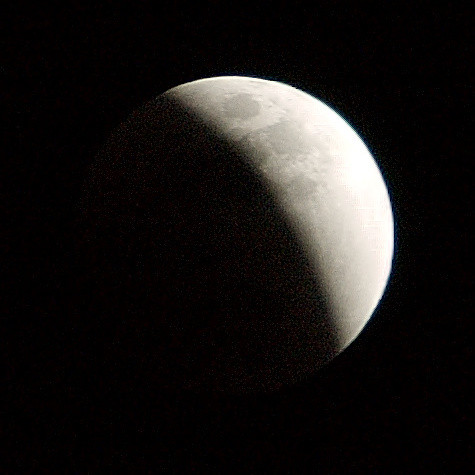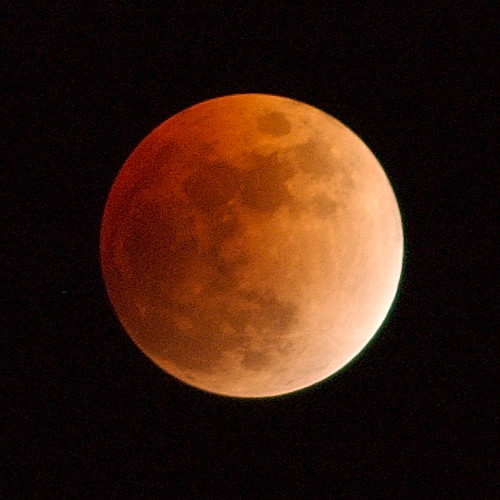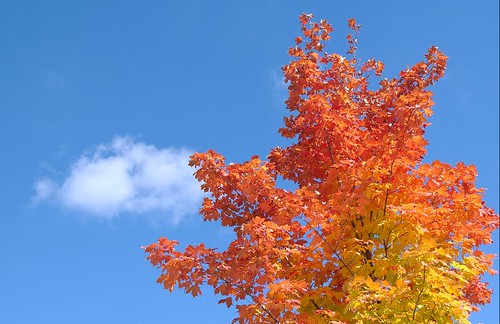Photo Friday - Black
 My first Photo Friday shot in a loooong time.
Just messing around with off-camera flash, trying to learn how to control the highlights and shadows.
My first Photo Friday shot in a loooong time.
Just messing around with off-camera flash, trying to learn how to control the highlights and shadows.
 My first Photo Friday shot in a loooong time.
Just messing around with off-camera flash, trying to learn how to control the highlights and shadows.
My first Photo Friday shot in a loooong time.
Just messing around with off-camera flash, trying to learn how to control the highlights and shadows.
I stayed up a little past my bedtime last night to watch the eclipse, and to try and take some pictures.
I've never had much luck taking pictures of the moon, but these ones turned out not too bad. What amazed me the most after looking through the pictures is just how fast the moon moves through the sky! I was using a 300mm lens on a D70 (equivalent to 450mm on a 35mm camera), and trying to bracket the exposure between shots. In just a few seconds between shots the moon moved a significant amount through the frame!


David Hobby is going to be starting a follow up to the very successful Lighting Boot Camp he ran last year. The next one, Lighting 102, starts on June 4th. I followed last year's boot camp pretty closely, although I wasn't able to do all of the assignments. Maybe I'll be able to complete more than a couple this year!
 I had the chance to head out today and take some pictures of the fall foliage around my apartment. This is one of my favourites, but you can see a couple more over on my Flickr page.
I had the chance to head out today and take some pictures of the fall foliage around my apartment. This is one of my favourites, but you can see a couple more over on my Flickr page.
I've been following the action over at Strobist for a few weeks now. The author of the blog, David Hobby, has a great writing style, and is a fantastic teacher. If you're interested in flash photography, I highly recommend you check out his site. There's something of a cult following on Flickr as well, and they've produced some very impressive results! I've had more than a couple "A HA!" moments when reading his blog, and I thought I'd share a couple of things that finally clicked in my brain in the hopes that it will help somebody else to "click"...or maybe everybody else just gets these things and I'm really slow. In any case, my first epiphany happened after reading several of his posts and thinking, what's with this guy's unhealthy obsession with aperture? I mean, sure, aperture is important if you want to control depth of field. But if you're want to change exposure you can tweak both the shutter speed and the aperture, right? Nope! Well, at least not in the same way as when you're just using available light. The thing is, your flash fires pretty fast. Way faster than your shutter speed in most cases. It's like 1/10,000th of a second. So it doesn't matter if your shutter is open for 1/500th of a second, or 1/30th of a second, the same amount of light from your flash is going to hit your sensor either way. But your aperture does affect how much light is able to reach your sensor from that brief burst of light. A larger aperture (smaller f/stop) lets more light in. This isn't to say that you can ignore your shutter speed, because it does affect how the ambient light contributes to the exposure. You can use this to your advantage to control the flash / ambient ratio. Understanding all of this led to my second "A HA!" moment. David often says to set your camera's shutter to its fastest flash sync speed to make things easier for your flash...which is a bit counter-intuitive at first. If you want things to be easier on your flash, you should have a longer shutter speed to let more light in! After thinking about it a bit more, I realized that choosing a faster shutter speed means that your aperture is opening up to maintain a proper exposure of the ambient light. And since the aperture is open wider, the flash doesn't have to put out as much light to light your subject properly. Which is great when you're competing with the sun as the primary light source :)
One of the podcasts I subscribe to is Dennis Hays' Secrets of Digital Imaging. In his June 19th Podcast, he spoke about the ongoing debate he has with his sister over whether or not digital photography is "real" photography. I thought I would post a few thoughts on this, since I found it an interesting topic for debate. I used to wonder whether a digital image printed from a lab was a "real" picture or not. From Wikipedia:
The word [photography] comes from the Greek words ??? phos ("light"), and ?????? graphis ("stylus", "paintbrush") or ????? graphê, together meaning "drawing with light" or "representation by means of lines" or "drawing."So when we take a picture we're using the light coming from our subject to draw a representation on our medium, whether that be film or a digital sensor. This is never an exact representation, nobody has invented a film or sensor that can capture all the light coming from a subject. What we're left with is an approximation that is meant to look the same to the human eye as the real thing. I don't know too much about film processing, but I do know that there are many techniques that a photographer can use in the darkroom to manipulate the final print, from how the film is developed, to how the image is enlarged onto the print paper. People have been burning and dodging, touching up dust specks and airbrushing images on film long before digital cameras came around. And film can always be scanned into a computer and edited with digital darkroom tools. Not to mention manipulating the actual environment (lighting, composition, etc.) to achieve a desired effect. On the digital side of things, yes, the digital format is easier for most people to edit, but does this make it less "real"? Film can be modified as well. On the plus side, some digital cameras can give us the guarantee that an image hasn't been modified, by using encryption techniques similar to what your bank's website uses to make sure that your browser can connect to it safely. This is extremely important for law enforcement work where you need to be able to show that an image has not been modified. Where does this leave us? Film and digital both capture light and record it, although in different ways. Film and digital images can both be altered to improve, repair, or even misrepresent the original subject. If by "real" we mean, "is this the same image that was captured by the camera?", then I believe that digital has the edge since we can use encryption techniques to ensure that a given image has not been modified. For the present, the majority of digital cameras do not have this capability...which means that it comes down to how much we trust the people involved in bringing the image from the subject to print. Did the photographer change anything? Did the lab technician? Did the publisher? Is that image in the newspaper or magazine trustworthy? Whether the photographer used a film camera or a digital camera is irrelevant to the answer.
I've been using Black's for the past little while to get my digital pictures developped. For the most part I'm pretty happy with the prints. I usually end up paying somewhere around $0.30 for a 4x6" print, and the quality seems good. The only time I had a problem with the prints I returned them and they reprinted at no cost. However, getting my pictures to Black's is a bit of a pain. Their only interface right now is an HTML form that allows you to upload 12 images at a time. So when I have a few dozen pictures I have to upload them in batches...and keep track of which ones have been uploaded, and which ones haven't. That means clicking on the "Browse" button for each image, and selecting the image from the list of all images in a directory. If I happen to miss one, I'm basically screwed, since they don't keep track of the original order of uploaded files, and am left to look through each of the images on my computer one by one to check if it's been uploaded. This probably isn't specific to Black's, so don't think that I'm picking on them. It's probably a consequence of the relative immaturity of the online photo processing industry. What I'd love to see is something that lets you upload a whole set of images in one go. I realize that this isn't possible with a standard JavaScript/HTML type application for security reasons. What about some kind of online photo service API? It could be XMLRPC / SOAP or some custom protocol, it doesn't matter much to me. The simplest case of this would just have to support user authentication and image uploads. Then we could write real client-side programs that would integrate much better with our photo management tools. Imagine being able to click "print" on an image in your photo management software, and having an order queued at your friendly neighbourhood online photo processing centre! You could manage the rest of the transaction via your browser if necesssary, like handling delivery and payment options. Has anybody heard of anything like this?
 Well, it's long past time when I should have had something posted about our trip to Europe. So without further ado, here's a short account of our trip to Europe, starting with our adventures in Spain.
We left for our trip on May 18, leaving from Toronto, flying through Munich, and finally landing in Barcelona. Other than arriving slightly late in Munich and worrying if our bags were going to make it with us to Barcelona the flight was great. We caught a nice view of the Alps as we came into Germany. We'll have to make another trip so we can enjoy them properly! We met up with Nat without a problem. She had been travelling already for 2 and a half weeks with Mel's older sister, Pam, and was waiting for us on a corner outside a particular café in Las Ramblas.
Barcelona is beautiful; it seems to me (a non-architect) an architectural paradise. There are so many wonderful bulidings by Gaudàto see that I think you'd need a few weeks fully explore them all! We were in Barcelona for 3 days, and in that time we managed to see Las Ramblas, La Pedrera, Casa Batllo, the Palau de Musica Catalan, the harbour, the Olympic Park, Poble Español, Sagrada Familia, Hospital Sant Pau, and Parc Güell.
Where to start? Antoni GaudÃÂ. For me, Gaudàwas the highlight of our trip to Barcelona. The man was a genius, as demonstrated by his innovative ways of combining artistic and functional elements into his architecture. Again, I know next to nothing about architecture, so some readers may be stifling a laugh right about now, but I don't mind! Gaudàmade the functional beautiful. My favourite building was La Sagrada Familia (the Sacred Family, meaning the family of Jesus, Mary, and Joseph). Apparently the roof is going to be completed within the next 3 years, so they'll be able to celebrate mass there for the first time since construction began in 1882!
As a city, Barcelona is quite nice. For the most part we felt quite comfortable getting around, and safe pretty much everywhere. It seems you have to be on the lookout for pickpockets everywhere, and there are many people trying to scam gullible tourists. It also seemed like we met more than our fair share of people who were not willing to go the extra mile (or even a metre...) to help us out. Maybe it's just culture shock, but for myself these experiences really tainted my impression of Spain.
After Barcelona, we took an overnight ferry to Mallorca. We rented a little Fiat Punto and did some touring around the island before heading to the beach to relax for the day. Mallorca is beautiful, and the people are very nice. It was great to relax on the beach for a day after walking all over Barcelona for 3 days straight. Too bad we couldn't stay there longer!
After Mallorca, we took the high speed ferry back to Barcelona, then got on a train to Madrid. For some reason we didn't have very high expectations for Madrid, and were regretting not spending another day or two in Mallorca and skipping Madrid altogether. How wrong we were! Madrid too has lots of beautiful architecture, history, and is easy to get around on foot in.
In Madrid we did a LOT of walking. The first day there we did two of the walking tours suggested in our travel book. The highlights of Madrid were the Basilica de San Francisco el Grande (sorry, no pictures!), and the Prado museum.
Next up...Paris!
Well, it's long past time when I should have had something posted about our trip to Europe. So without further ado, here's a short account of our trip to Europe, starting with our adventures in Spain.
We left for our trip on May 18, leaving from Toronto, flying through Munich, and finally landing in Barcelona. Other than arriving slightly late in Munich and worrying if our bags were going to make it with us to Barcelona the flight was great. We caught a nice view of the Alps as we came into Germany. We'll have to make another trip so we can enjoy them properly! We met up with Nat without a problem. She had been travelling already for 2 and a half weeks with Mel's older sister, Pam, and was waiting for us on a corner outside a particular café in Las Ramblas.
Barcelona is beautiful; it seems to me (a non-architect) an architectural paradise. There are so many wonderful bulidings by Gaudàto see that I think you'd need a few weeks fully explore them all! We were in Barcelona for 3 days, and in that time we managed to see Las Ramblas, La Pedrera, Casa Batllo, the Palau de Musica Catalan, the harbour, the Olympic Park, Poble Español, Sagrada Familia, Hospital Sant Pau, and Parc Güell.
Where to start? Antoni GaudÃÂ. For me, Gaudàwas the highlight of our trip to Barcelona. The man was a genius, as demonstrated by his innovative ways of combining artistic and functional elements into his architecture. Again, I know next to nothing about architecture, so some readers may be stifling a laugh right about now, but I don't mind! Gaudàmade the functional beautiful. My favourite building was La Sagrada Familia (the Sacred Family, meaning the family of Jesus, Mary, and Joseph). Apparently the roof is going to be completed within the next 3 years, so they'll be able to celebrate mass there for the first time since construction began in 1882!
As a city, Barcelona is quite nice. For the most part we felt quite comfortable getting around, and safe pretty much everywhere. It seems you have to be on the lookout for pickpockets everywhere, and there are many people trying to scam gullible tourists. It also seemed like we met more than our fair share of people who were not willing to go the extra mile (or even a metre...) to help us out. Maybe it's just culture shock, but for myself these experiences really tainted my impression of Spain.
After Barcelona, we took an overnight ferry to Mallorca. We rented a little Fiat Punto and did some touring around the island before heading to the beach to relax for the day. Mallorca is beautiful, and the people are very nice. It was great to relax on the beach for a day after walking all over Barcelona for 3 days straight. Too bad we couldn't stay there longer!
After Mallorca, we took the high speed ferry back to Barcelona, then got on a train to Madrid. For some reason we didn't have very high expectations for Madrid, and were regretting not spending another day or two in Mallorca and skipping Madrid altogether. How wrong we were! Madrid too has lots of beautiful architecture, history, and is easy to get around on foot in.
In Madrid we did a LOT of walking. The first day there we did two of the walking tours suggested in our travel book. The highlights of Madrid were the Basilica de San Francisco el Grande (sorry, no pictures!), and the Prado museum.
Next up...Paris!
